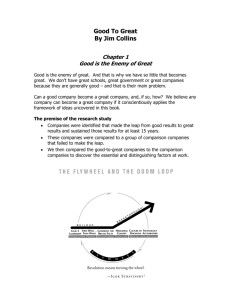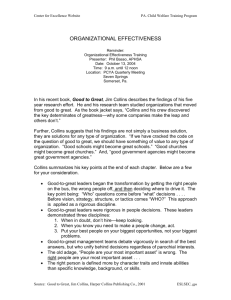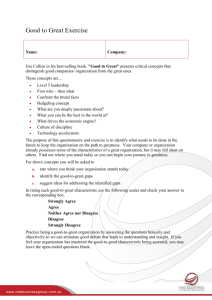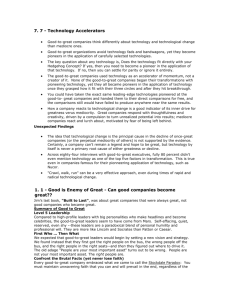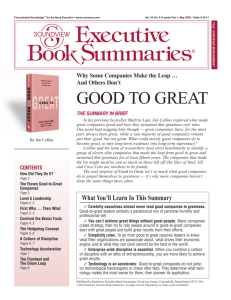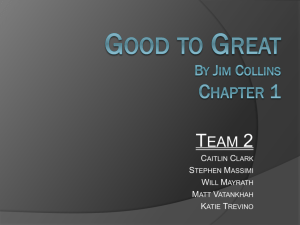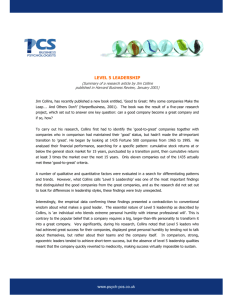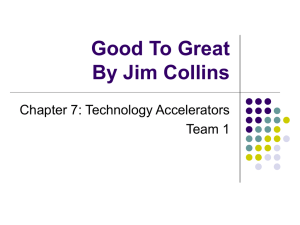Good to Great - Asher Strategies
advertisement
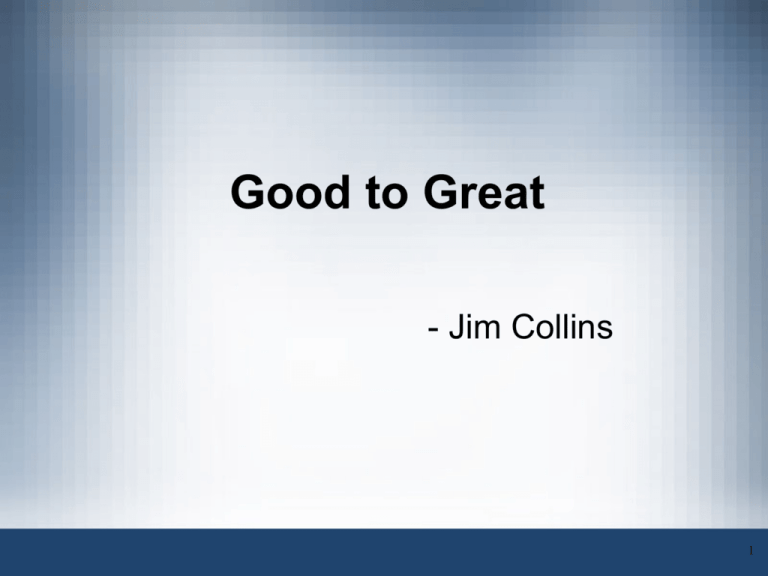
Good to Great - Jim Collins 1 The Study Set Good-to-Great Companies Abbot Circuit City Fannie Mae Gillette Kimberly-Clark Kroger Nucor Philip Morris Pitney Bowes Walgreens Wells Fargo Direct Comparison Upjohn Silo Great Western Warner-Lambert Scott Paper A&P Bethlehem Steel R.J. Reynolds Addressograph Eckerd Bank of America 2 The Successful Model BREAKTHROUGH BUILDUP… Level 5 Technology Leadership First Who… Then what Disciplined People Confront the Brutal Facts Concept Disciplined Thought Hedgehog Culture of Discipline Disciplined Action 3 Leadership • Level 5 Level 5 Executive Builds enduring greatness through a paradoxical blend of personal humility and professional will. • Level 4 Effective Leader Catalyzes commitment to and vigorous pursuit of a clear and compelling vision, stimulating higher performance standards. • Level 3 Competent Manager Organizes people and resources toward the effective and efficient pursuit of predetermined objectives. • Level 2 Contributing Team Member Contributes individual capabilities to the achievement of group objectives and works effectively with others in a group setting. • Level 1 Highly Capable Individual Makes productive contributions through talent, knowledge, skills and good work habits. 4 Level 5 Leadership Key Points 1 of 2 • Every good-to-great company had Level 5 leadership during the pivotal transition years. • “Level 5” refers to a five-level hierarchy of executive capabilities, with Level 5 at the top. Level 5 leaders embody a paradoxical mix of personal humility and professional will. They are ambitious, to be sure, but ambitious first and foremost for the company, not themselves. • Level 5 leaders set up their successors for even greater success in the next generation, whereas egocentric Level 4 leaders often set up their successors for failure. • Level 5 leaders display a compelling modesty, are self-effacing and understated. In contrast, two thirds of the comparison companies had leaders with gargantuan personal egos that contributed to the demise or continued mediocrity of the company. • Level 5 leaders are fanatically driven, infected with an incurable need to produce sustained results. They are resolved to do whatever it takes to make the company great, no mater how big or hard the decision. 5 Level 5 Leadership Key Points 2 of 2 • Level 5 leaders display a workmanlike diligence – more plow horse than show horse. • Level 5 leaders look out the window to attribute success to factors other than themselves. When things go poorly, however, they look in the mirror and blame themselves, taking full responsibility. The comparison CEOs often did just the opposite – they looked in the mirror to take credit for their success, but out the window to assign blame for disappointing results. • One of the most damaging trends in recent history is the tendency (especially by boards of directors) to select dazzling, celebrity leaders to de-select potential Level 5 leaders. • I believe that potential Level 5 leaders exist all around us, if we just know what to look for, and that many people have the potential to evolve into Level 5. 6 The Flywheel and the Doom Loop Key Points 1 of 2 • Good-to-great transformations often look like dramatic, revolutionary events to those observing from the outside, but they feel like organic cumulative processes to people on the inside. The confusion of end outcomes (dramatic results) with process (organic and cumulative) skews our perception of what really works over the long haul. • No matter how dramatic the end result the good-to-great transformations never happened in one fell swoop. There was no single defining action, no grand program, no one killer innovation, no solitary lucky break, no miracle moment. • Sustainable transformations follow a predictable pattern of buildup and breakthrough. Like pushing on a giant, heavy flywheel, it takes a lot of effort to get the thing moving at all, but with persistent pushing in a consistent direction over a long period of time, the flywheel builds momentum, eventually hitting a point of breakthrough. 7 The Flywheel and the Doom Loop Key Points 2 of 2 • The comparison companies followed a different pattern, the doom loop. Rather than accumulating momentum – turn by turn of the flywheel – they tried to skip buildup and jump immediately to breakthrough. Then, with disappointing results, they’d lurch back and forth, failing to maintain a consistent direction. • The comparison companies frequently tried to create a breakthrough with large, misguided acquisitions. The goodto-great companies, in contrast, principally used large acquisitions after a breakthrough, to accelerate momentum in an already fast spinning flywheel. 8 The Flywheel and the Doom Loop Unexpected Results • Those inside the good-to-great companies were often unaware of the magnitude of their transformation at the time; only later, in retrospect, did it become clear. They had no name, tag line, launch event, or program to signify what they were doing at the time. • The good-to-great leaders spent essentially no energy trying to “create alignment,” “motivate the troops,” or “manage change.” Under the right conditions, the problems of commitment, alignment, motivation, and change largely take care of themselves. Alignment principally follows from results and momentum, not the other way around. • The short-term pressures of Wall Street were not inconsistent with following this model. The flywheel effect is not in conflict with these pressures. Indeed, it is the key to managing them. 9 First Who…Then What 1 of 2 • The good-to great leaders began the transformation by first getting the right people on the bus (and the wrong people off the bus) and then figured out where to drive it. They selected people based on their natural talents for jobs. • The key point of this chapter is not just the idea of getting the right people on the team. The key point is that “who” questions come before “what” decisions – before vision, before strategy, before organization structure, before tactics. First who, then what – as a rigorous discipline, consistently applied. • The comparison companies frequently followed the “genius with a thousand helpers” model – a genius leader who sets a vision and then enlists a crew of highly capable “helpers” to make the vision happen. This model fails when the genius departs. • The good-to-great leaders were rigorous, not ruthless, in people decisions. They did not rely on layoffs and restructuring as a primary strategy for improving performance. The comparison companies used layoffs to a much greater extent. 10 First Who…Then What 2 of 2 • We uncovered three practical disciplines for being rigorous in people decisions: 1. 2. 3. • When in doubt, don’t hire – keep looking (Corollary: A company should limit its growth based on its ability to attract enough of the right people.) When you know you need to make a people change, act. (Corollary: First be sure you don’t simply have someone in the wrong seat.) Use aptitude assessments to figure it out. Put your best people on your biggest opportunities, not your biggest problems. (Corollary: If you sell off your problems, don’t sell off your best people.) Good-to-great management teams consist of people who debate vigorously in search of the best answers, yet who unify behind decisions, regardless of parochial interests. 11 Confront the Brutal Facts 1 of 2 • All good-to great companies began the process of finding a path to greatness by confronting the brutal facts of their current reality. • When you start with an honest and diligent effort to determine the truth of your situation, the right decisions often become self-evident. It is impossible to make good decisions without infusing the entire process with an honest confrontation of the brutal facts. • A primary task in taking a company from good to great is to create a culture wherein people have a tremendous opportunity to be heard and, ultimately, for the truth to be heard. 12 Confront the Brutal Facts 2 of 2 • Creating a climate where the truth is heard involves four basic practices: 1. 2. 3. 4. Lead with questions, not answers. Engage in dialogue and debate, not coercion. Conduct autopsies, without blame. Build red flag mechanisms that turn information into information that cannot be ignored. • The good-to great companies faced just as much adversity as the comparison companies, but responded to that adversity differently. They hit the realities of their situation head-on. As a result, they emerged from adversity even stronger. • A key psychology for leading from good to great is the Stockdale Paradox. Retain absolute faith that you can and will prevail in the end, regardless of the difficulties, AND at the same time confront the most brutal facts of your current reality, whatever they might be. 13 Confront the Brutal Facts Unexpected Findings • Charisma can be as much a liability as an asset, as the strength of your leadership personality can deter people from bringing you the brutal facts. • Leadership does not begin just with vision. It begins with getting people to confront the brutal facts and to act on the implications. • Spending time and energy trying to “motivate” people is a waste of effort. The real question is not, “How do we motivate our people?” If you have the right people based on their natural talent for the job, they will be selfmotivated.The key is to not de-motivate them. One of the primary ways to de-motivate people is to ignore the brutal facts of reality. 14 Hedgehog Concept (Simplicity within the Three Circles) To go from good to great required a deep understanding of three intersecting circles translated into a simple, crystalline concept (the Hedgehog Concept): What you are deeply PASSIONATE ABOUT What you can BE THE BEST IN THE WORLD AT What drives your ECONOMIC ENGINE 15 Three Circles of the Hedgehog Concept 1 of 2 • The key is to understand what your organization can be the best in the world at, and equally important what it cannot be the best at – not what it “wants” to be the best at. The Hedgehog Concept is not a goal, a strategy, or intention; it is an understanding. • If you cannot be the best in the world at your core business, then your core business cannot form the basis of your Hedgehog Concept. • The “best in the world” understanding is a much more severe standard than a core competence. You might have a competence but not necessarily have the capacity to be truly the best in the world at that competence. Conversely, there may be activities at which you could become the best in the world, but at which you have no current competence. 16 Three Circles of the Hedgehog Concept 2 of 2 • To get insight into the drivers of your economic engine, search for the one denominator (profit per x or, in the social sector, cash flow per x) that has the single greatest impact. • Good-to-great companies set their goals and strategies based on understanding comparison companies set their goals and strategies based on bravado. • Getting the Hedgehog Concept is an iterative process. The Council can be a useful device. 17 Three Circles of the Hedgehog Concept Unexpected Findings • The good-to-great companies are more like hedgehogs – simple, dowdy creatures that know “one big thing” and stick to it. The comparison companies are more like foxes – crafty, cunning creatures that know many things yet lack consistency. • It took four years on average for the good-to-great companies to get a Hedgehog Concept. • Strategy per se did not separate the good-to-great companies from the comparison companies. Both sets had strategies, and there is no evidence that the good-to-great companies spent more time on strategic planning than the comparison companies. • You absolutely do not need to be in a great industry to produce sustained great results. No matter how bad the industry, every good-to-great company figured out how to produce truly superior economic returns. 18 Start a “STOP DOING” LIST 19 A Culture of Discipline Key Points 1 of 2 • Sustained great results depend upon building a culture full of self-disciplined people who take disciplined action, fanatically consistent with the three circles. • Bureaucratic cultures arise to compensate for incompetence and lack of discipline, which arise from having the wrong people on the bus in the first place. If you get the right people on the bus, and the wrong people off, you don’t need stultifying bureaucracy. • A culture of discipline involves a duality. On the one hand, it requires people who adhere to a consistent system; yet, on the other hand, it gives people freedom and responsibility within the framework of that system. • A culture of discipline is not just about action. It is about getting disciplined people who engage in disciplined thought and who then take disciplined action. 20 A Culture of Discipline Key Points 2 of 2 • The good-to-great companies appear boring and pedestrian looking in from the outside, but upon closer inspection, they’re full of people who display extreme diligence and a stunning intensity (they “rinse their cottage cheese”). • Do not confuse a culture of discipline with a tyrant who disciplines – they are very different concepts, one highly functional, the other highly dysfunctional. Savior CEOs who personally discipline through sheer force of personality usually fail to produce sustained results. • The single most important form of discipline for sustained results is fanatical adherence to the Hedgehog Concept and the willingness to shun opportunities that fall outside the three circles. 21 A Culture of Discipline Unexpected Findings • The more an organization has the discipline to stay within its three circles, with almost religious consistency, the more it will have opportunities for growth. • The fact that something is a “once-in-a-lifetime opportunity” is irrelevant, unless it fits within the three circles. A great company will have many once-in-a-lifetime opportunities. • The purpose of budgeting in a good-to-great company is not to decide how much each activity gets, but to decide which arenas best fit with the Hedgehog Concept and should be fully funded and which should not be funded at all. • “Stop doing” lists are more important that “to do” lists. 22 Technology Accelerators Key Points 1 of 2 • Good-to-great organizations think differently about technology and technological change than mediocre ones. • Good-to-great organizations avoid technology fads and bandwagons, yet they become pioneers in the application of carefully selected technologies. • The key question about any technology is, Does the technology fit directly with your Hedgehog Concept? If yes, then you need to become a pioneer in the application of that technology. If no, then you can settle for parity or ignore it entirely. • The good-to-great companies used technology as an accelerator of momentum, not a creator of it. None of the good-to-great companies began their transformations with pioneering technology, yet they all became pioneers in the application of that technology once they grasped how it fit with their three circles and after they hit breakthrough. 23 Technology Accelerators Key Points 2 of 2 • You could have taken the exact same leadingedge technologies pioneered at the good-to-great companies and handed them to their direct comparison for free, and their comparisons still would have failed to produce anywhere near the same results. • How a company reacts to technological change is a good indicator of its inner drive for greatness versus mediocrity. Great companies respond with thoughtfulness and creativity, driven by a compulsion to turn unrealized potential into results; mediocre companies react and lurch about, motivated by fear of being left behind. 24 Technology Accelerators Unexpected Findings • The idea that technological change is the principal cause in the decline of once-great companies (or the perpetual mediocrity of others) is not supported by the evidence. Certainly, a company can’t remain a laggard and hope to be great, but technology by itself is never a primary root cause of either greatness or decline. • Across eighty-four interviews with good-to-great executives, fully 80 percent didn’t even mention technology as one of the top five factors in the transformation. This is true even in companies famous for their pioneering application of technology, such as Nucor. • “Crawl, walk, run” can be a very effective approach, even during times of rapid and radical technological change. 25

